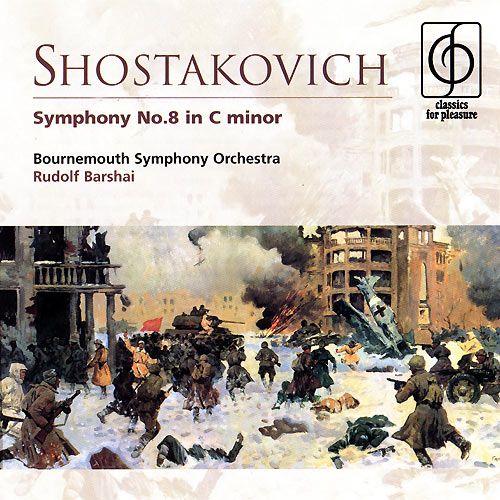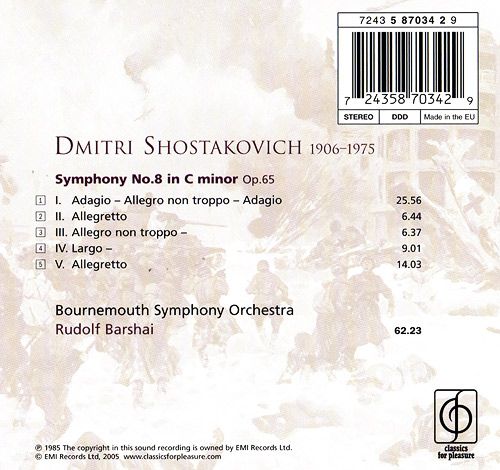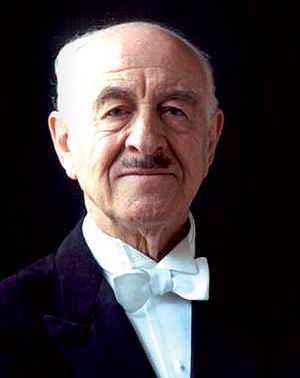wimpel69
11-27-2014, 11:42 AM
EAC-FLAC link below. This is my own rip. Complete artwork,
LOG and CUE files included. Do not share. Buy the original!
Please leave a "Like" or "Thank you" if you enjoyed this!
Just as his countryman Prokofiev wrote a trilogy of so-called War Sonatas for piano, one might say that
Dmitri Shostakovich composed a trio of war symphonies, of which this work is the second and surely
the greatest. It was preceded by the "Leningrad" symphony, a programmatic composition whose artistically
dubious Bolero-like first movement buildup, now thought by some to signify the banality of evil, was originally
said to represent the heroism of those defending Leningrad against the Nazi invaders. The Symphony No.8
is surrounded by no such controversy, and is a far more profound work. Like its predecessor, it exudes an
atmosphere of war and struggle, of loss and hope. But here pain and destruction become the dominant issues,
replacing the Seventh's admirable but more na�ve themes of heroism and triumph.
The Eighth came at a time when Soviet censors were completely occupied with the war. Shostakovich had c
ome under attack in January 1936, for his opera Lady Macbeth of Mtsensk and thereafter had to modify his
expressive language, even though he was hardly in the vanguard of modernism. Now the situation was
changed: Prokofiev got away with writing his Piano Sonata No. 7, which even received a Stalin prize despite
a first movement that flirted with atonality and a finale rife with dissonance. Thus Shostakovich was free to
write a darker, deeper, more challenging work. But its tragic character was mainly a by-product of the war
and of the composer's own often naturally pessimistic musical persona.
The massive first-movement Adagio is nearly as long as the other four combined. Its music is dark and tense
throughout, consisting of an introductory theme and two long-breathed, dark melodies that form the main
and secondary subjects. These two explode in the catastrophic development section, climaxed by a brutal
fugal march based on the first theme. A three-note motif that appears in different guises (C-B flat-C, C-D-C,
or B-C-B) serves as a motto throughout symphony and launches both of the first movement's main themes.
After the explosive development section, the music seems to go into a tailspin for the remainder of the
movement.
The ensuing Allegretto seems at times to suggest joviality, but quickly undercuts that feeling with an
ironic twist or a turn toward desperation. The driving, neurotic Allegro non troppo that follows offers a
theme that races breathlessly along, propelled, it seems, by bombs dropping in the distance. After a
somewhat bombastic middle section, the theme returns and explodes in a percussive outburst, after
which the Largo passacaglia begins without pause. The theme here, gloomy and profound and related
to the first movement's second theme, repeats a dozen times, imparting a mood throughout of loss,
if not of despair.
The finale begins with the three-note motif. While there are suggestions of relief from the oppressive
strife and tragedy, the music is mostly devoid of strong emotions, as if to express a sense of numbness
due to the war's terrors. The music suddenly erupts near the end of this 15-minute panel, however, with
huge sustained chords that recall the catastrophic moments from the earlier movements. The three-note
motif is heard repeatedly in the quiet that follows, and the symphony ends in a mood of resignation
and drained emotions.
The Eighth Symphony was premiered on November 4, 1943, and Shostakovich and the work's
conductor, Evgeny Mravinsky, received a half-hour ovation. Five years later, however, the composer
was chastised for writing the symphony by Zhdanov and the party censors.

Music Composed by
Dmitri Shostakovich
Played by the
Bournemouth Symphony Orchestra
Conducted by
Rudolf Barshai

"A fine performance and hardly less impressive recording, which holds up surprisingly well on all counts
against the competition it faces from its celebrated Decca rival. The noble symphonic adagio which
opens the work is marvellously sustained and the playing of the Bournemouth orchestra is extremely
fine in all departments. It is broader and comes closer to the tragic core of the movement than did
the late Kirill Kondrashin and the Moscow Philharmonic.
The Eighth has not been recorded so often as the Fifth and Tenth Symphonies�or even the Fourteenth�
and in recent years, until the Haitink version with the Concertgebouw Orchestra came along, Previn
and the LSO had the field to themselves. So often an impersonal conductor, Previn is at his best in
this work (HMV ASD2917, 10/73�nla): nor is there any want of personality in this Barshai account.
I was both held and moved by this finely paced and powerful reading, which particularly in the first
movement, has a wonderfully brooding intensity and eloquence. In the Allegretto, Barshai adopts
the recommended crotchet = 132, and I dare say most listeners will at first think this too slow;
Haitink, Previn and Mravinsky are appreciably faster. However, it is what the composer asks for,
and the result inevitably seems weightier. In the third movement Barshai is less successful in
sustaining tension and momentum, the whiteheat of the Mravinsky and Haitink performances;
the passage between bars 198-240 is just a bit laboured, I think, but he certainly has the full
measure of the Passacaglia, and the finale.
True, it was Barshai who conducted the first recording of the Fourteenth Symphony (HMV ASD2633,
3/71�nla) but, to be frank, I had not expected a performance of quite such epic sweep from his
baton. So far as sound quality is concerned, the balance could hardly be improved upon and
excellent acoustic is used to splendid and often thrilling effect. This is a very formidable
competitor and no one buying it will be greatly disappointed.'"
Gramophone[/B

[B]Download Link - https://mega.co.nz/#!ycAXBTSb!nlvHcj2P5AipQTL-pDbEfVeEo1ypEHVNjuqcaktSd40
Source: EMI "Classics for Pleasure" CD, 1985/2005 (my rip!)
Format: FLAC(RAR), DDD Stereo, Level: -5
File Size: 274 MB (incl. artwork, booklet, log & cue)
Enjoy! Don't share! Buy the origina! Please leave a "Like" or "Thank you" if you enjoyed this! :)
LOG and CUE files included. Do not share. Buy the original!
Please leave a "Like" or "Thank you" if you enjoyed this!
Just as his countryman Prokofiev wrote a trilogy of so-called War Sonatas for piano, one might say that
Dmitri Shostakovich composed a trio of war symphonies, of which this work is the second and surely
the greatest. It was preceded by the "Leningrad" symphony, a programmatic composition whose artistically
dubious Bolero-like first movement buildup, now thought by some to signify the banality of evil, was originally
said to represent the heroism of those defending Leningrad against the Nazi invaders. The Symphony No.8
is surrounded by no such controversy, and is a far more profound work. Like its predecessor, it exudes an
atmosphere of war and struggle, of loss and hope. But here pain and destruction become the dominant issues,
replacing the Seventh's admirable but more na�ve themes of heroism and triumph.
The Eighth came at a time when Soviet censors were completely occupied with the war. Shostakovich had c
ome under attack in January 1936, for his opera Lady Macbeth of Mtsensk and thereafter had to modify his
expressive language, even though he was hardly in the vanguard of modernism. Now the situation was
changed: Prokofiev got away with writing his Piano Sonata No. 7, which even received a Stalin prize despite
a first movement that flirted with atonality and a finale rife with dissonance. Thus Shostakovich was free to
write a darker, deeper, more challenging work. But its tragic character was mainly a by-product of the war
and of the composer's own often naturally pessimistic musical persona.
The massive first-movement Adagio is nearly as long as the other four combined. Its music is dark and tense
throughout, consisting of an introductory theme and two long-breathed, dark melodies that form the main
and secondary subjects. These two explode in the catastrophic development section, climaxed by a brutal
fugal march based on the first theme. A three-note motif that appears in different guises (C-B flat-C, C-D-C,
or B-C-B) serves as a motto throughout symphony and launches both of the first movement's main themes.
After the explosive development section, the music seems to go into a tailspin for the remainder of the
movement.
The ensuing Allegretto seems at times to suggest joviality, but quickly undercuts that feeling with an
ironic twist or a turn toward desperation. The driving, neurotic Allegro non troppo that follows offers a
theme that races breathlessly along, propelled, it seems, by bombs dropping in the distance. After a
somewhat bombastic middle section, the theme returns and explodes in a percussive outburst, after
which the Largo passacaglia begins without pause. The theme here, gloomy and profound and related
to the first movement's second theme, repeats a dozen times, imparting a mood throughout of loss,
if not of despair.
The finale begins with the three-note motif. While there are suggestions of relief from the oppressive
strife and tragedy, the music is mostly devoid of strong emotions, as if to express a sense of numbness
due to the war's terrors. The music suddenly erupts near the end of this 15-minute panel, however, with
huge sustained chords that recall the catastrophic moments from the earlier movements. The three-note
motif is heard repeatedly in the quiet that follows, and the symphony ends in a mood of resignation
and drained emotions.
The Eighth Symphony was premiered on November 4, 1943, and Shostakovich and the work's
conductor, Evgeny Mravinsky, received a half-hour ovation. Five years later, however, the composer
was chastised for writing the symphony by Zhdanov and the party censors.

Music Composed by
Dmitri Shostakovich
Played by the
Bournemouth Symphony Orchestra
Conducted by
Rudolf Barshai

"A fine performance and hardly less impressive recording, which holds up surprisingly well on all counts
against the competition it faces from its celebrated Decca rival. The noble symphonic adagio which
opens the work is marvellously sustained and the playing of the Bournemouth orchestra is extremely
fine in all departments. It is broader and comes closer to the tragic core of the movement than did
the late Kirill Kondrashin and the Moscow Philharmonic.
The Eighth has not been recorded so often as the Fifth and Tenth Symphonies�or even the Fourteenth�
and in recent years, until the Haitink version with the Concertgebouw Orchestra came along, Previn
and the LSO had the field to themselves. So often an impersonal conductor, Previn is at his best in
this work (HMV ASD2917, 10/73�nla): nor is there any want of personality in this Barshai account.
I was both held and moved by this finely paced and powerful reading, which particularly in the first
movement, has a wonderfully brooding intensity and eloquence. In the Allegretto, Barshai adopts
the recommended crotchet = 132, and I dare say most listeners will at first think this too slow;
Haitink, Previn and Mravinsky are appreciably faster. However, it is what the composer asks for,
and the result inevitably seems weightier. In the third movement Barshai is less successful in
sustaining tension and momentum, the whiteheat of the Mravinsky and Haitink performances;
the passage between bars 198-240 is just a bit laboured, I think, but he certainly has the full
measure of the Passacaglia, and the finale.
True, it was Barshai who conducted the first recording of the Fourteenth Symphony (HMV ASD2633,
3/71�nla) but, to be frank, I had not expected a performance of quite such epic sweep from his
baton. So far as sound quality is concerned, the balance could hardly be improved upon and
excellent acoustic is used to splendid and often thrilling effect. This is a very formidable
competitor and no one buying it will be greatly disappointed.'"
Gramophone[/B

[B]Download Link - https://mega.co.nz/#!ycAXBTSb!nlvHcj2P5AipQTL-pDbEfVeEo1ypEHVNjuqcaktSd40
Source: EMI "Classics for Pleasure" CD, 1985/2005 (my rip!)
Format: FLAC(RAR), DDD Stereo, Level: -5
File Size: 274 MB (incl. artwork, booklet, log & cue)
Enjoy! Don't share! Buy the origina! Please leave a "Like" or "Thank you" if you enjoyed this! :)